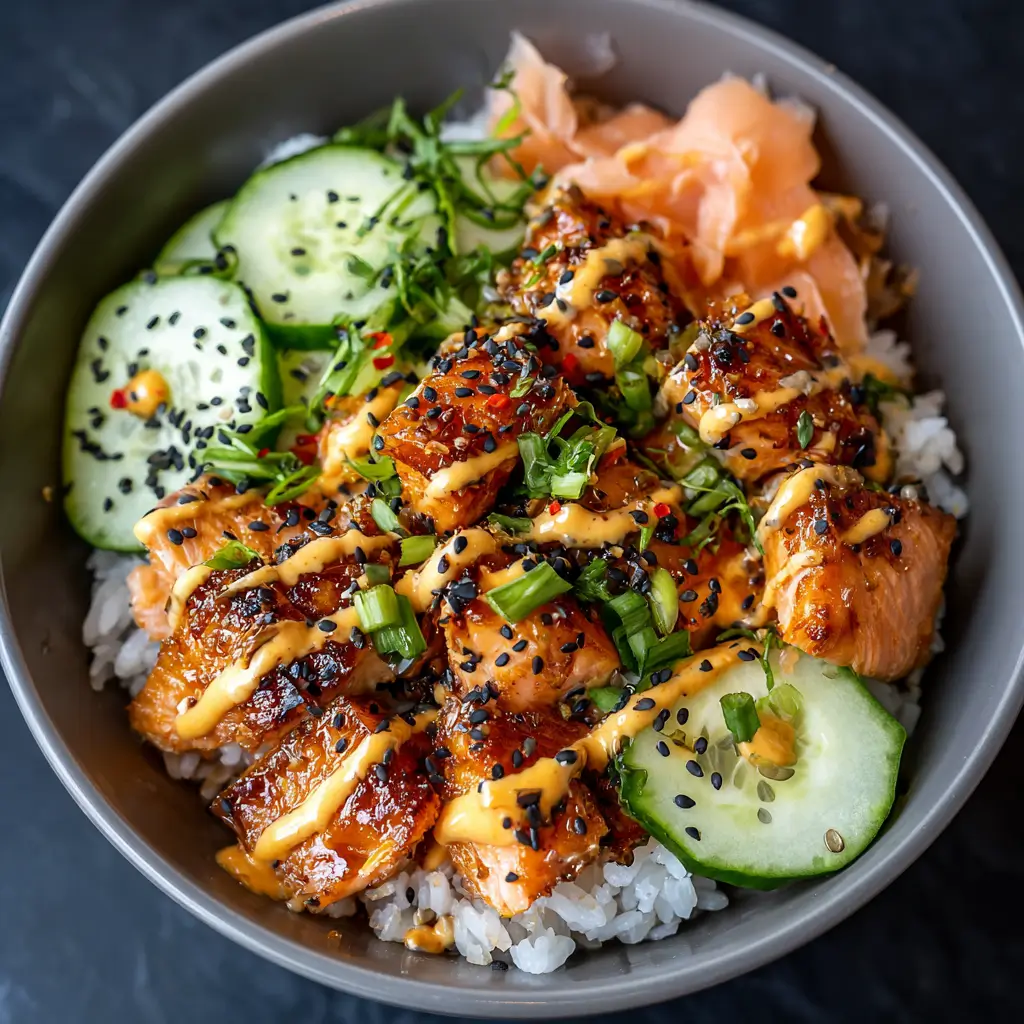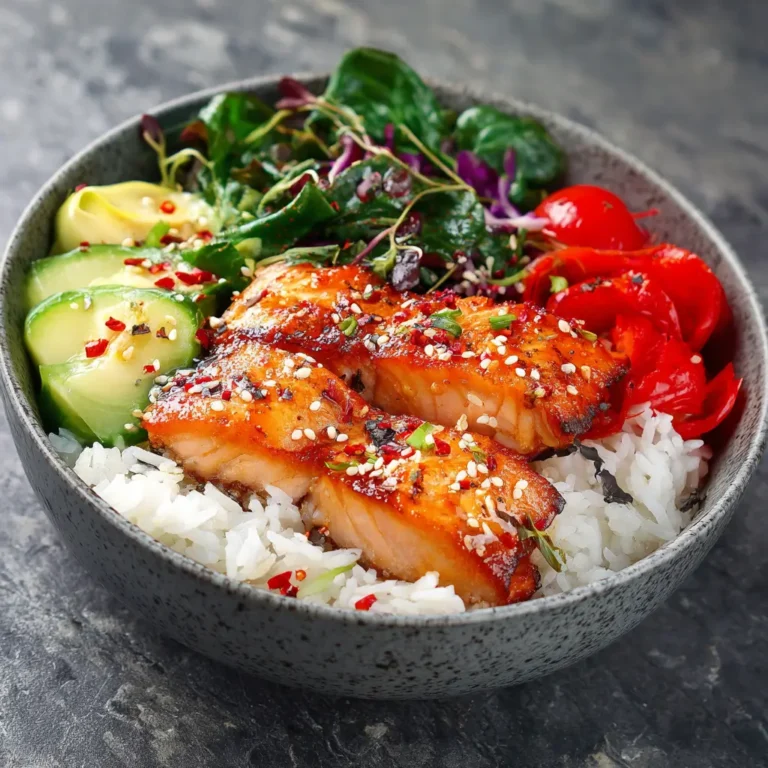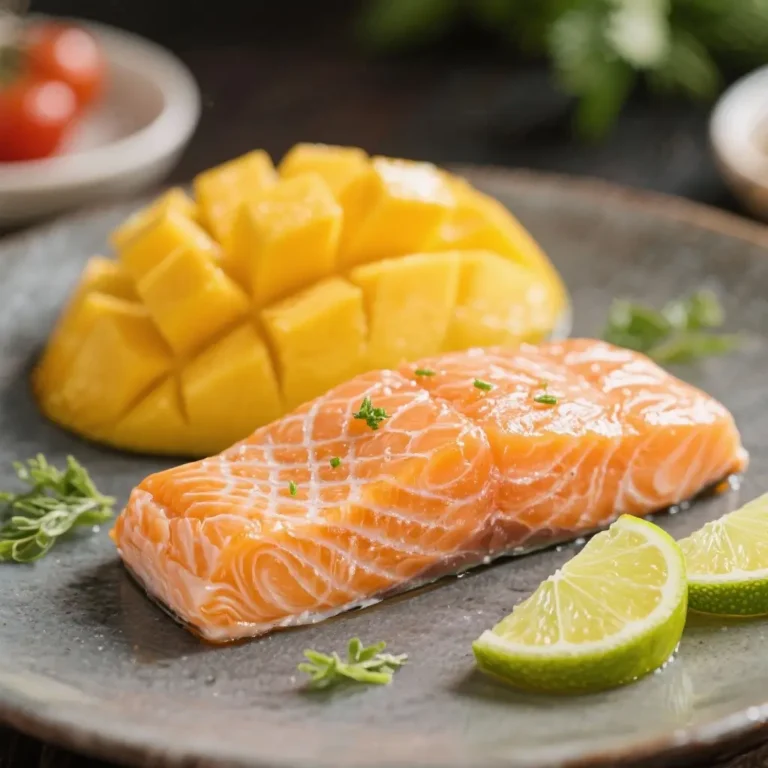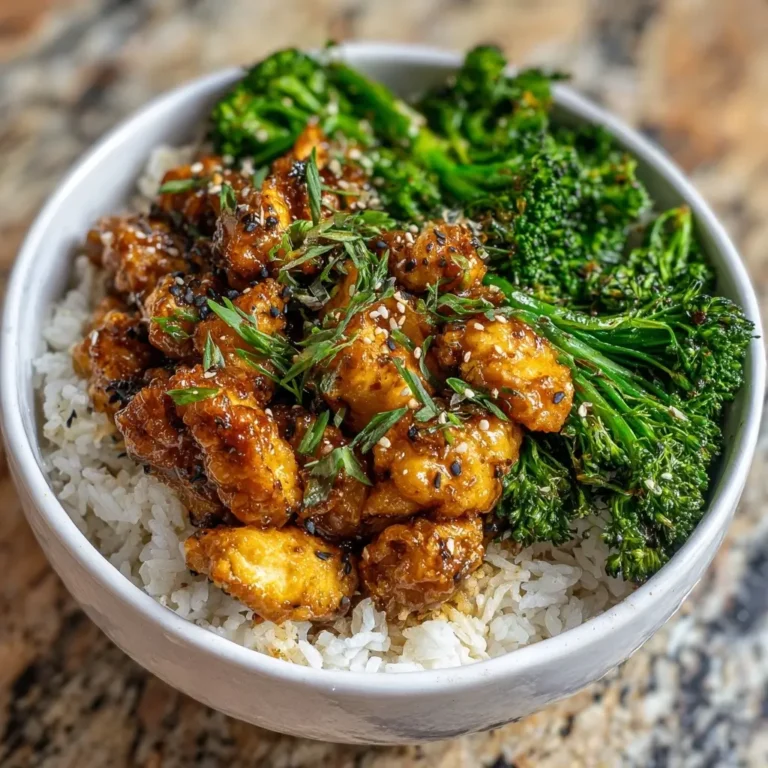Spicy Salmon Sushi Bowls
Spicy Salmon Sushi Bowls: A Flavorful Fusion Delight
Spicy Salmon Sushi Bowls are a modern twist on traditional Japanese sushi, combining the bold flavors of spicy salmon with the comforting texture of sushi rice, fresh vegetables, and a medley of sauces and toppings. This dish is perfect for those who love sushi but want a less structured, more customizable meal that can be enjoyed with a spoon instead of chopsticks. The beauty of sushi bowls lies in their versatility — you can easily tailor the ingredients to your preferences or dietary needs while enjoying the same umami-packed flavors.
The History of Spicy Salmon Sushi Bowls
Sushi bowls, also known as “sushi donburi” or “sashimi don,” have roots in Japan where they are commonly served in bowls with rice and various toppings. However, the spicy salmon version is a more modern, Westernized take, influenced by the popularity of spicy mayo rolls in American sushi restaurants. The combination of heat from spicy mayo or Sriracha with the richness of salmon became a favorite among sushi lovers looking for something bolder and more flavorful than traditional nigiri or maki rolls. This dish has since become a staple at sushi bars and home kitchens alike, especially in the United States.
Ingredients Breakdown
The key to a great spicy salmon sushi bowl is using high-quality, fresh ingredients. Here’s a breakdown of what you’ll need:
- Sushi Rice: Short-grain Japanese rice seasoned with rice vinegar, sugar, and salt. It provides the base and a slightly tangy flavor.
- Salmon: Fresh or frozen sushi-grade salmon, ideally wild-caught for best flavor and color.
- Spicy Mayo: A mix of mayonnaise and Sriracha (or chili garlic sauce), giving the dish its signature kick.
- Vegetables: Common choices include cucumber, avocado, carrots, edamame, and scallions for crunch and freshness.
- Seaweed: Nori strips or furikake (Japanese seasoning blend with seaweed, sesame seeds, and fish flakes) for umami and texture.
- Soy Sauce: For drizzling or dipping.
- Sesame Seeds: Adds a nutty flavor and visual appeal.
- Egg: Optional tamagoyaki (sweet Japanese omelet) or a fried egg for extra richness.
Step-by-Step Recipe
- Cook the Sushi Rice: Rinse 1 ½ cups sushi rice until water runs clear. Cook in a rice cooker or pot with 1 ¾ cups water. Once cooked, mix with a seasoning of 2 tbsp rice vinegar, 1 tsp sugar, and ½ tsp salt while still warm.
- Prepare the Salmon: Marinate 2 salmon fillets in a mix of soy sauce, ginger, and garlic for 15–30 minutes. Pan-sear or bake until just cooked through. Alternatively, use raw sushi-grade salmon if you prefer sashimi-style.
- Make the Spicy Mayo: Combine ½ cup mayonnaise with 1–2 tbsp Sriracha (adjust to taste).
- Prepare the Toppings: Slice avocado, cucumber, and carrots into matchsticks. Chop scallions and toast sesame seeds if desired.
- Assemble the Bowls: In a bowl, layer sushi rice, flaked salmon, vegetables, and any additional toppings. Drizzle with spicy mayo and soy sauce, then sprinkle with sesame seeds and nori or furikake.
Tips for the Perfect Sushi Bowl
- Use sushi-grade salmon if eating raw. Always source from a reputable fishmonger or store.
- To enhance flavor, lightly sear the salmon for a crispy exterior and tender interior.
- If you’re not a fan of raw fish, pan-sear or bake the salmon first.
- Keep the rice warm while assembling to maintain its sticky texture.
- Customize your toppings with pickled vegetables like radish or daikon for extra flavor and crunch.
- For extra heat, add a dash of Tabasco or chili oil to the spicy mayo.
Variations and Customizations
The beauty of sushi bowls is that they can be customized to suit any palate or dietary preference. Here are some popular variations:
- Vegan Option: Replace salmon with marinated tofu, avocado slices, or grilled mushrooms.
- Low-Carb Version: Substitute sushi rice with cauliflower rice or shirataki noodles.
- Protein Swap: Use tuna, shrimp, chicken, or beef instead of salmon.
- Extra Creamy: Add a drizzle of unagi sauce or a soft-boiled egg on top.
- Vegetarian Twist: Omit fish and load up on avocado, edamame, carrots, and pickled vegetables.
Health Considerations and Nutritional Value
Spicy Salmon Sushi Bowls are not only delicious but also packed with nutrients:
- Omega-3 Fatty Acids: Salmon is rich in heart-healthy omega-3s that support brain and cardiovascular health.
- Complex Carbohydrates: Sushi rice provides energy, though portion control is key for balanced blood sugar levels.
- Fiber and Vitamins: Vegetables like cucumber and avocado add fiber, vitamins, and antioxidants.
- Healthy Fats: Avocado and sesame seeds contribute healthy monounsaturated fats.
Be mindful of sodium content from soy sauce and spicy mayo — consider using low-sodium soy sauce and reducing the amount of added salt in the rice.
Ingredients
- 1 ½ cups sushi rice
- 1 ¾ cups water
- 2 tbsp rice vinegar
- 1 tsp sugar
- ½ tsp salt
- 2 salmon fillets (sushi-grade or regular for cooking)
- 2 tbsp soy sauce (plus extra for drizzling)
- 1 tbsp grated ginger
- 2 cloves garlic, minced
- ½ cup mayonnaise
- 1–2 tbsp Sriracha (adjust to taste)
- 1 avocado, sliced
- ½ cucumber, julienned
- ¼ cup shredded carrots
- 2 tbsp chopped scallions
- 1 tbsp sesame seeds (white and/or black)
- Nori strips or furikake (optional)
Directions
- Rinse the sushi rice under cold water until the water runs clear. Cook in a rice cooker or pot with 1 ¾ cups water until tender and fluffy.
- Mix rice vinegar, sugar, and salt in a small bowl. Once the rice is done, gently fold in the vinegar mixture while the rice is still warm.
- In a small bowl, combine soy sauce, ginger, and garlic. Brush over salmon fillets and let marinate for 15–30 minutes.
- Heat a skillet over medium-high heat and cook salmon until browned and cooked through (or skip cooking if using raw sushi-grade salmon).
- Mix mayonnaise and Sriracha in a bowl to create the spicy mayo.
- In four serving bowls, divide the sushi rice evenly. Top each with flaked salmon, avocado, cucumber, carrots, and scallions.
- Drizzle with spicy mayo and soy sauce. Sprinkle with sesame seeds and nori or furikake if desired.
FAQ
Can I use frozen salmon?
Yes, but make sure it’s fully thawed and patted dry. If using raw, it must be labeled “sushi-grade” or “sashimi-grade”.






